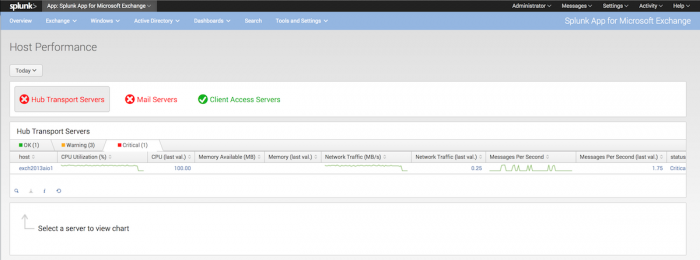Host Performance Reports
The Host Performance Reports page lets you see the status of your Exchange servers based on their Exchange server role. It displays the status of each host in a host group based on specific factors such as memory, CPU usage, disk space, and network traffic. It rates the health of each host based on those factors.
How to use this page
When the page initially loads, you see three status indicators for Hub Transport servers, Mail servers, and Client Access servers. The indicators show the status of each group of hosts:
- If all host in the group function normally, the status indicator shows a checkmark with the text in green.
- If any host in the group has warnings, the status indicator shows an exclamation icon with text in yellow.
- If any host in the group has a critical error, the status indicator shows an "x" icon with text in red.
You can then click on one of the status indicators to get a tabbed list of the hosts in that group. The list has three tabs, "OK", "Warning", and "Critical".
The list categorizes hosts based on the status they report. For example, if a host reports itself as "Critical", the list shows the server under the "Critical" tab. Each tab also shows a count of the number of hosts that report a certain status.
Each host in the list has columns that show CPU usage, available memory, network traffic, messages per second, and a status based on these factors. The CPU, memory, network traffic, and messages per second columns also have corresponding spark lines that show recent activity over time. You might need to scroll right to see all available counters.
- To switch between the different lists based on status, click the desired tab at the top of the list.
- To sort the list of hosts by a certain metric (such as CPU usage or network traffic), click the column header of the metric you want to sort by. You can toggle between sorting the metrics in ascending order or descending order.
- To show a graph of recent host activity for a given host, click the host in the list. The app opens a second chart that displays this information.
Additional options
- You can click the magnifying glass icon in the lower left corner of each panel to display the base search that produced the panel.
- You can mouse over any line in a panel to see individual values for that plot.
- You can click on a point in any chart to load the Performance Monitoring page for the hosts that generate the chosen chart data.
| Perfmon | Client Access Servers |
This documentation applies to the following versions of Splunk® App for Microsoft Exchange (EOL): 3.4.1


 Download manual
Download manual
Feedback submitted, thanks!